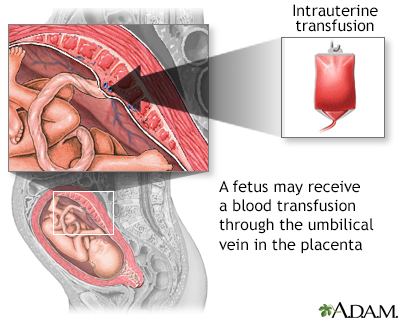Hemolytic disease of the newborn
Hemolytic disease of the fetus and newborn (HDFN); Erythroblastosis fetalis; Anemia - HDN; Blood incompatibility - HDN; ABO incompatibility - HDN; Rh incompatibility - HDN
Hemolytic disease of the newborn (HDN) is a blood disorder in a fetus or newborn infant. In some infants, it can be fatal.
Normally, red blood cells (RBCs) last for about 120 days in the body. In this disorder, RBCs in the blood are destroyed quickly and thus do not last as long.
Images


Causes
During pregnancy, RBCs from the unborn baby can cross into the mother's blood through the placenta. HDN occurs when the immune system of the mother sees a baby's RBCs as foreign. Antibodies then develop against the baby's RBCs. These antibodies attack the RBCs in the baby's blood and cause them to break down too early.
HDN may develop when a mother and her unborn baby have different blood types. The types are based on small substances (antigens) on the surface of the blood cells.
There is more than one way in which the unborn baby's blood type may not match the mother's.
- A, B, AB, and O are the 4 major blood group antigens or types. This is the most common form of a mismatch. In most cases, this is not very severe.
- Rh is short for the "rhesus" antigen or blood type. People are either positive or negative for this antigen. If the mother is Rh-negative and the baby in the womb has Rh-positive cells, her antibodies to the Rh antigen can cross the placenta and cause very severe anemia in the baby. It can be prevented in most cases.
- There are other, much less common, types of mismatch between minor blood group antigens. Some of these can also cause severe problems.
Symptoms
HDN can destroy the newborn baby's blood cells very quickly, which can cause symptoms such as:
- Edema (swelling under the surface of the skin)
- Newborn jaundice which occurs sooner and is more severe than normal
Exams and Tests
Signs of HDN include:
- Anemia or low blood count
- Enlarged liver or spleen
- Hydrops (fluid throughout the body's tissues, including in the spaces containing the lungs, heart, and abdominal organs), which can lead to heart failure or respiratory failure from too much fluid
Which tests are done depends on the type of blood group incompatibility and the severity of symptoms, but may include:
- Complete blood count and immature red blood cell (reticulocyte) count
- Bilirubin level
- Blood typing
Treatment
Infants with HDN may be treated with:
- Feeding often and receiving extra fluids.
- Light therapy (phototherapy) using special blue lights to convert bilirubin into a form which is easier for the baby's body to get rid of.
- Antibodies (intravenous immunoglobulin, or IVIG) to help protect the baby's red cells from being destroyed.
- Medicines to raise blood pressure if it drops too low.
- In severe cases, an exchange transfusion may need to be performed. This involves removing a large amount of the baby's blood, and thus the extra bilirubin and antibodies. Fresh donor blood is infused.
- Simple transfusion (without exchange). This may need to be repeated after the baby goes home from the hospital.
Outlook (Prognosis)
The severity of this condition can vary. Some babies have no symptoms. In other cases, problems such as hydrops can cause the baby to die before, or shortly after, birth. Severe HDN may be treated before birth by intrauterine blood transfusions.
Prevention
The most severe form of this disease, which is caused by Rh incompatibility, can be prevented if the mother is tested during pregnancy. If needed, she is given a shot of a medicine called RhoGAM at certain times during and after her pregnancy. If you have had a baby with this disease, talk with your health care provider if you plan to have another baby.
Related Information
AntibodyRh incompatibility
Intrauterine
Swelling
Anemia
Exchange transfusion
References
Kemper AR, Newman TB, Slaughter JL, et al. Clinical Practice Guideline Revision: Management of hyperbilirubinemia in the newborn infant 35 or more weeks of gestation. Pediatrics. 2022;150(3):e2022058859. PMID: 35927462 pubmed.ncbi.nlm.nih.gov/35927462/.
Rodrigue BB, Sloan SR. Pediatric transfusion medicine. In: Hoffman R, Benz EJ, Silberstein LE, et al, eds. Hematology: Basic Principles and Practice. 8th ed. Philadelphia, PA: Elsevier; 2023:chap 119.
Simmons PM, Magann EF. Immune and non-immune hydrops fetalis. In: Martin RJ, Fanaroff AA, Walsh MC, eds. Fanaroff and Martin's Neonatal-Perinatal Medicine: Diseases of the Fetus and Infant. 11th ed. Philadelphia, PA: Elsevier; 2020:chap 23.
BACK TO TOPReview Date: 12/31/2023
Reviewed By: Mary J. Terrell, MD, IBCLC, Neonatologist, Cape Fear Valley Medical Center, Fayetteville, NC. Review provided by VeriMed Healthcare Network. Also reviewed by David C. Dugdale, MD, Medical Director, Brenda Conaway, Editorial Director, and the A.D.A.M. Editorial team.

Health Content Provider
06/01/2025
|
A.D.A.M., Inc. is accredited by URAC, for Health Content Provider (www.urac.org). URAC's accreditation program is an independent audit to verify that A.D.A.M. follows rigorous standards of quality and accountability. A.D.A.M. is among the first to achieve this important distinction for online health information and services. Learn more about A.D.A.M.'s editorial policy, editorial process and privacy policy. A.D.A.M. is also a founding member of Hi-Ethics. This site complied with the HONcode standard for trustworthy health information from 1995 to 2022, after which HON (Health On the Net, a not-for-profit organization that promoted transparent and reliable health information online) was discontinued. |
The information provided herein should not be used during any medical emergency or for the diagnosis or treatment of any medical condition. A licensed medical professional should be consulted for diagnosis and treatment of any and all medical conditions. Links to other sites are provided for information only -- they do not constitute endorsements of those other sites. © 1997- 2025 A.D.A.M., a business unit of Ebix, Inc. Any duplication or distribution of the information contained herein is strictly prohibited.
